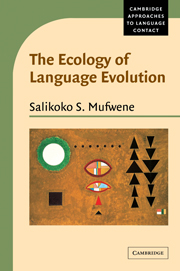Book contents
- Frontmatter
- Contents
- List of illustrations
- Preface
- Acknowledgments
- 1 Introduction
- 2 The Founder Principle in the development of creoles
- 3 The development of American Englishes: factoring contact in and the social bias out
- 4 The legitimate and illegitimate offspring of English
- 5 What research on the development of creoles can contribute to genetic linguistics
- 6 Language contact, evolution, and death: how ecology rolls the dice
- 7 Past and recent population movements in Africa: their impact on its linguistic landscape
- 8 Conclusions: the big picture
- Notes
- References
- Author index
- Subject index
8 - Conclusions: the big picture
Published online by Cambridge University Press: 18 December 2009
- Frontmatter
- Contents
- List of illustrations
- Preface
- Acknowledgments
- 1 Introduction
- 2 The Founder Principle in the development of creoles
- 3 The development of American Englishes: factoring contact in and the social bias out
- 4 The legitimate and illegitimate offspring of English
- 5 What research on the development of creoles can contribute to genetic linguistics
- 6 Language contact, evolution, and death: how ecology rolls the dice
- 7 Past and recent population movements in Africa: their impact on its linguistic landscape
- 8 Conclusions: the big picture
- Notes
- References
- Author index
- Subject index
Summary
The main working assumptions and primary themes of this book regarding language evolution, as they apply to creole and noncreole languages, were detailed in chapter 1. Each of the other chapters articulates its own conclusions, which need not be repeated here. Below, I focus on the big picture that emerges from these discussions.
From the development of creoles to language evolution from a population genetics perspective
Creole vernaculars are not outcomes of abnormal, unusual, or unnatural developments in language evolution. Rather, they make more evident restructuring processes that must have taken place in the evolutions of other languages. In this book, I have advocated approaching language evolution from combined ecological and population genetics perspectives. Among the working assumptions of this approach is that a language is like a parasitic, Lamarckian species, although it has some structural properties that are distinctively linguistic. These peculiarities bear on its evolutionary patterns and account for the respects in which linguistic evolution differs from some established principles in biological evolution.
I have shown, nonetheless, that some principles of biological evolution are applicable to linguistic evolution. The language-as-species analogy maintains that languages as complex adaptive systems have lives; some die while others come into existence, as a consequence of what their speakers qua hosts do. The analogy is more adequate than the language-as-organism trope inherited from the nineteenth century. For instance, we can factor language-internal variation in our accounts of linguistic evolution and thereby make better use of external and internal ecological factors that trigger or influence evolutionary processes.
- Type
- Chapter
- Information
- The Ecology of Language Evolution , pp. 192 - 207Publisher: Cambridge University PressPrint publication year: 2001

